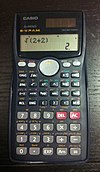Casio 9860 series
| Introduced | 2005 |
|---|---|
| Calculator | |
| Entry mode | Infix, Natural display |
| Display type | LCD Dot matrix monochrome |
| Display size | 128 x 64 pixels |
| CPU | |
| Processor | SuperH 3 |
| Frequency | 29 MHz |
| Programming | |
| User memory | 64 KiB |
| Firmware memory | Flash memory, 1.5 MiB (800 KiB for AU version) |
| External memory | Up to 1GB for SD version with an SD memory card |
| Interfaces | |
| Connects to | PC via one of:
|
The 9860 series are CASIO manufactured graphing calculators. Some of the improvements compared to older models are: Natural Display, a USB port, flash memory, upgradeable OS (through ROM updates) and a high contrast display LCD.
Variants
There are several versions of the fx-9860G; the standard fx-9860G, often referred to as the 'vanilla' flavor, and the SD, AU and Slim versions.
- The AU version limits the amount of internal flash memory available to 800 KiB to meet Australian school regulations.
- The SD variant comes with an SD expansion card slot, allowing read and write access to up to 1GiB of memory on a SD memory card.
- The Slim version has a backlit display, on-board help, and is designed as a clamshell to minimize its size.
- The fx-9860GII and fx-9860GII SD were announced recently and will be available in May 2009. These calculators have backlit displays and the Geometry (in user mem) and ECON2 apps preinstalled. They also have new mathematical functions. [1]
The usual fx-9860G and fx-9860G SD are marketed in France as Graph85 and Graph85 SD.
The french versions of the GII models are the Graph 75 and Graph 95. The Australian version of the GII is the fx-9860G AU PLUS.
Programming
The calculators can be programmed through a couple of ways. The fx-9860G's come with a built-in BASIC-like interpreter, allowing the user to create simple programs, using built-in functionality.
The other method is to create an add-in. Add-ins are binary programs, executing directly on the calculators CPU. CASIO has released two official add-ins, GEOMETRY and PHYSIUM. An SDK was released by CASIO in 2006, allowing users to create their own add-ins, though no support is provided for this by CASIO. The add-ins and the SDK are available for registered users at CASIO's website.
Add-ins and the SDK allowed more powerful applications to be developed, and has been used to create an interpreter for the popular Multi-Platform Language for Calculators.

